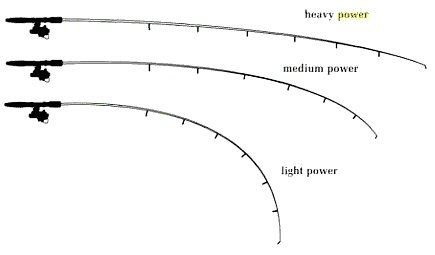
Fishing rods unique characteristics used by manufacturers to describe fishing rod.
There are numeral things that describe a rod and its performance, but the most important out of them that you have to consider when choosing a rod are how the rod controls the presentation of the bait and how you are feeling the bite and setting up the hook. Fishing rods are identified by their weight (meaning the weight of line or lure required to flex a fully-loaded rod) and Action (describing the location of the maximum flex along the length of the rod), Power (the "strength" of the rod or ability to lift weight from the tip; it is the amount of force needed to bend the rod), Stiffness, Shape, Number of pieces, Balance and Length (longer rod allows you to cast at a greater distance and it also affects your ability to fight against a fish).
Power
Power also known as "Power Value" or "Rod Weight" generally refers to a rod's stiffness/resistance to bending. Fishing rods may be classified as Ultra-Light, Light, Medium-Light, Medium, Medium-Heavy, Heavy, Ultra-Heavy, or other similar combinations. Power usually shows you what types of fishing, species of fish, or size of fish a particular fishing pole may be best used for.
The following list details the types of rod power, and the corresponding line and lure weight they would be best matched up with.

Ultra Light
Light
Medium
Medium Heavy
Heavy
Extra Heavy
1 to 4lb Test
4 to 8lb Test
4 to 12lb Test
8 to 14lb Test
15 - 25lb Test
25lb Test and Above
1/64 - 1/16oz
1/32 - 1/8oz
1/8 - 3/8oz
3/16 - 1/2 oz
up to 1 1/2 oz
1 1/2 oz and Above
Ultra-light rods are best for catching small bait fish like panfish. Extra-Heavy rods are used for heavy fish in surf and deep sea fishing. Any fish can be caught with any rod, but catching panfish on a heavy rod offers no fun at all. Why people like to catch bigger fish? They fight harder. Why people tend to use the lightest equipment possible? To accentuate the fight, to make it the most entertaining and exciting fight it can give you. What could be more entertaining than fighting a really big one with the lightest tackle and finally winning the fight? And successfully landing a large fish like musky on an ultra-light rod requires incredible rod handling skills at best, and although the challenge can be quite fun, more frequent than not, it can ends up in a broken tackle and/or a lost fish. Therefore it is best to match the rod to the type of fish you intend to catch.
More about fishing rods Power...
Back to topAction
Action describes how much of the rod bends when you put pressure on the tip, and the speed with which the rod returns to its neutral position, it is used to describe the flex point of a rod and may be slow, medium, fast or a combination. The construction material and construction method of a rod affects its action. A Fast action rod will flex in the upper 1/3 of the blank, a Medium/Moderate action will flex in the upper 1/2 of its length and a Slow action will flex all the way to the butt.
Fast Action rod will bend very little, in only the upper 1/3 or less of the blank. A rod of this type is ideal for large game fishing, or when fishing extremely heavy cover or weeds. A fast action rod will allow you to set the hook hard and powerfully. Musky, pike and largemouth bass are suited to this style of rod. Fast action rods are great for most species where a short to long casting distance is involved and single hooks are the rule, such as worm and jig fishing.
Most bass rod actions are fast to very fast because this action provides better sensitivity and faster power for hook setting. By faster power we mean the rod 'shuts off' faster, or the bend ends higher on the blank, which means you don't have to move the rod as far on the hook set to get into the stiffer part of the blank
Medium/Moderate Action: A medium or moderate action rods will bend in the top half of their length, allowing an angler to fish both for small and large species with good control and hook setting allowances. These rods will allow a fisherman to fish in a wide range of situations and for a varied list of species. These rods will usually offer a little more casting distance and provide plenty of hook setting power.
Slow Action: A slow action rod will bend throughout the whole length of the rod, providing the most flexible action available. These rods are used exclusively for small fish, like a panfish, allowing a better fight for the angler. It also acts as a shock absorber so that the hook is not ripped clear through the fish mouth.
These actions are often used for species that involve treble hooks. The 'bite' of a treble hook is not as deep as a big single worm hook and it is easier to tear the hook out of a strong fish, plus the slower action will not pull the lure out of the fish's mouth before it fully engulfs it. The type of lure you use will usually determine the action of the rod you should use.
Taper
Often used synonymously with "action", taper describes not only the thickness of the rod but also the thickness of the wall of the blank and where along the blank less material is used allowing more bend. Rod taper is the reduction in diameter that occurs between the butt and tip. The smaller diameter of the tip allows it to bend more easily than the thicker butt section of the rod. The lower half of a rod provides casting and fish fighting power. The upper, thinner half of the rod provides shock absorption when casting and fighting fish. By changing the taper the action of a rod can also change by changing the point where the rod bends significantly.
Graphite classified by the tensile modulus (modulus of elasticity) of the carbon fibers, the measure of stiffness, how far the material stretches for a given stress. The higher the modulus of the carbon fiber used, the lighter blank can be produced for any given stiffness. Graphite by itself is very strong and increasing high modulus of blanks makes the rods lighter, more sensitive and more efficient due to the ability to make blanks with thinner walls. Rod tapers vary for different situations but for most cases taper is the same as action.
More about fishing rods Action...
Back to topResponsiveness
Related to the modulus and stiffness the responsiveness of a rod blanks is the ability of the entire rod to flex under the load to store the energy and then release this stored energy in the cast. Rod can be created from different materials with different layers, all of which contributes to the responsiveness of the rod. The relationship between modulus and responsiveness is as follows, the higher the modulus, the faster and more consistent the rod can store and release energy. For fishing, this means anglers will cast more efficiently and accurately with high-modulus rods. The lighter and thinner the rod, especially the tip, the more responsive it will be.
Back to top
Weight
Weight is one of the important characteristics fishing rod is described by, especially when it comes for using it long periods. A light weight rods are more sensitive for feeling both bites and bottom. However if too much pressure is applied they are very easy to break, especially tips some fast action rods. However, you can get a fast tip extremely light rod that won't break, if you can handle it properly.
Weight refers to how resilient the rod will be for specific types of lures and for specific types of fish. Therefore, classifications ranging from Ultra-Light to Ultra Heavy are used when describing fishing rods or fishing poles to help the fisherman in choosing the correct one for his objectives. Fly fishing, for instance, can be managed with Ultra-Light to Medium weight rods. Bass fishing, on the other hand, would require Medium-Light to Heavy weight rods.
Line weight
A rod is classified by the optimal weight of fishing line or in the case of fly rods, fly line the rod should handle. Fishing line weight is described in pounds of tensile force before the line parts. Line weight for a rod is expressed as a range that the rod can support. Fly rod weights are typically articulated as a number from 1wt. to 12wt. and each weight represents a standard weight in grains for the first 30 feet of the fly line. For example, the first 30' of a 6wt fly line should weigh between 152-168 grains, and the optimal weight is 160 grains. In casting and spinning rods, designations such as "8-15 lb. line" are typical.
A rod's action and power may change when line weight is greater or smaller than the rod's specified range. When the line weight used greatly exceeds a rod's specifications a rod may break before the line parts. When the line weight is significantly less than the rod's recommended range the line may part too early, as the rod cannot fully flex to lodge the pull of a given weight fish. In fly rods, exceeding weight ratings may warp the blank or have casting difficulties when rods are improperly loaded.
Lure weight
A rod may also be described by the weight of lure or hook that the rod is designed to support. Lure weight is usually expressed in ounces or grams.
Back to top
Shape
A fishing rod should taper off from its base to its tip. Advanced designs are introduced to the market every now and then, but the classic is still the best choice.
Number of pieces
Fishing rods can be broken down into any number of sections, depending on the length of the pole and the type of fishing you intend to do. Most fishing rods are designed in one or two pieces. Travel rods however, can be pulled apart in multiple sections. A telescoping fishing rod that fits easily in a suitcase or trunk would be great for the traveler who enjoys fishing. Though multiple sections may cause some loss of sensitivity and power, not having to travel with a nine foot fishing rod may out weigh any potential control issues.
Rods that are one piece from butt to tip are considered to have the most natural "feel", but the difficulty in transporting them safely becomes a huge problem with increasing rod length. Two-piece rods, joined by a ferrule, are very common, and if well engineered with carbon fiber materials, give up very little in the way of natural feel.
Back to top
Length

The shorter rod provides more control and maneuverability, more accuracy when making the cast, allowing you to flick cast in tight areas much easier. A long-handled rod will gives you more power for greater casting distance. It covers more open water where long two-handed casts are required. The longer handle also gives you much more power when playing a large fish than a short-handled rod. It allows you to move line quicker. It takes up line and sets the hook well from a distance. It provides a shock-absorber action and also can give you more control on fish during the fight.
The longer the rod, the greater the mechanical advantage in casting, it allows you to cast further. Bigger rods are used for bigger bait and bigger fish. The bigger the fish, the longer the cast, so the longer the rod should be.
Back to top
Stiffness
Stiffness describes how much force it takes to bend it. It is a ratio between the applied weight and the amount of flexible bend of a rod. The stiffer the rod, the less flexible it is. Stiffness depends on the materials used the rod made of and the amount of material used. A stiff rod makes less accuracy of casting lighter bait but the same time it lets you set the hook faster and harder and help of pulling a fish out of heavy cover. Too stiff of rod may rip the hooks out of the fish's mouth.
Recovery, Sensitivity and Brittleness
Recovery is a measure of the time it takes the rod to recover after a cast. When you impart energy to a rod upon casting, it vibrates. You can see the tip shaking. That shaking bats the line as it leaves the top guide, causing friction. That friction reduces casting distance. Faster action rods tend to recover faster, but do not load up as well. More moderate action rods tend to recover poorly, but load up better. If you can find a moderate action rod with fast recovery, it will outcast everything else if the rest of the playing field is equal.
Sensitivity is obviously important. You want a rod to be able to transmit the feelings you experience when your lure moves underwater, where you can't see it. Higher modulus graphite is more sensitive, although it may be a case of diminishing returns as you get higher and higher up the modulus rating scale.
Brittleness is how easily the rod will break. Most high end rods are brittle, as brittleness and sensitivity tend to be indirectly proportional.
Balance
Balance is a set of greatly increases sensitivity and fatigue. The balance point should be right where you hold the rod. A rod is a simple lever and the closer you get to a neutral fulcrum the better feeling and working the rod will be. For spinning and casting rods it could be somewhere in the midpoint of the reel sits. For the pole rods, crappie rods, Hera rods and Tenkara rods it should be on the handle right where you hold the rod.
Back to top


































